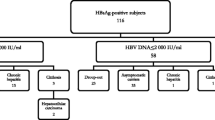Abstract
Background
The continuing migration of individuals from geographic areas with high/medium endemicity has determined the arrival of new chronic hepatitis B virus (HBV) carriers in Italy. The magnitude of this phenomenon and clinical/virological features of HBsAg-positive migrants remain not very well defined.
Aims
To evaluate the proportion of HBsAg-positive immigrants enrolled in this multicenter Società Italiana di Malattie Infettive e Tropicali (SIMIT) cross-sectional study and to compare the characteristics of chronic hepatitis B infection in migrants to those of Italian carriers.
Methods
From February 1 to July 31 2008, anonymous data were obtained from all HBsAg-positive patients aged ≥18 years observed at 74 Italian centers of infectious diseases.
Results
Of the 3,760 HBsAg-positive subjects enrolled, 932 (24.8 %) were immigrants, with a prevalent distribution in central to northern Italy. The areas of origin were: Far East (37.1 %), Eastern Europe (35.4 %), Sub-Saharan Africa (17.5 %), North Africa (5.5 %), and 4.5 % from various other sites. Compared to Italian carriers, migrants were significantly younger (median age 34 vs. 52 years), predominantly female (57.5 vs. 31 %), and most often at first observation (incident cases 34.2 vs. 13.3 %). HBeAg-positives were more frequent among migrants (27.5 vs. 14 %). Genotype D, found in 87.8 % of Italian carriers, was present in only 40 % of migrants, who were more frequently inactive HBV carriers, with a lower prevalence of chronic hepatitis, cirrhosis, and hepatocellular carcinoma (HCC). Only 27.1 % of migrants received antiviral treatment compared to 50.3 % of Italians.
Conclusions
Twenty-five percent of all HBV carriers examined at Italian centers was composed of immigrants with demographic, serological, and virological characteristics that differed from those of natives and appeared to have an inferior access to treatment.


Similar content being viewed by others
References
Stroffolini T, Mele A, Tosti ME, et al. The impact of hepatitis B mass immunization campaign on the incidence and risk factors of acute hepatitis B in Italy. J Hepatol. 2000;33:980–5.
Stroffolini T. The changing pattern of hepatitis B virus infection over the past three decades in Italy. Dig liver Dis. 2005;37:622–627.
Caritas Italiana/Migrantes. Dossier Statistico Immigrazione 2011. XXI Rapporto. Edizioni Idos Roma. http://www.dossierimmigrazione.it/libro.php?cid=47_52&pid=145.
Stroffolini T, Bianco E, Szklo A, et al. Factors affecting the compliance of the antenatal hepatitis B screening programme in Italy. Vaccine. 2003;21:1246–9.
Scotto G, Saracino A, Pempinello R, et al.; Gruppo Italiano per lo Studio delle Malattie Infettive negli Immigrati. Epidemiologic multicenter study of the prevalence of hepatitis in hospitalised immigrants in Italy in the year 2002. Ann Ig. 2005;17:11–8.
Da Villa G, Romanò L, Sepe A, et al. Impact of hepatitis B vaccination in a highly endemic area of south Italy and long-term duration of anti-HBs antibody in two cohorts of vaccinated individuals. Vaccine. 2007;25:3133–6.
Spada E, Tosti ME, Zuccaro O, Stroffolini T, Mele A; Collaborating Study Group. Evaluation of the compliance with the protocol for preventing perinatal hepatitis B infection in Italy. J Infect. 2011;62:165–71.
Sánchez-Tapias JM, Costa J, Mas A, Bruguera M, Rodés J. Influence of hepatitis B virus genotype on the long-term outcome of chronic hepatitis B in western patients. Gastroenterology. 2002;123:1848–56.
Yuen MF, Sablon E, Yuan HJ, et al. Significance of hepatitis B genotype in acute exacerbation, HBeAg seroconversion, cirrhosis-related complications, and hepatocellular carcinoma. Hepatology. 2003;37:562–7.
Sumi H, Yokosuka O, Seki N, et al. Influence of hepatitis B virus genotypes on the progression of chronic type B liver disease. Hepatology. 2003;37:19–26.
McMahon BJ. The influence of hepatitis B virus genotype and subgenotype on the natural history of chronic hepatitis B. Hepatol Int. 2009;3:334–42.
Cao GW. Clinical relevance and public health significance of hepatitis B virus genomic variations. World J Gastroenterol. 2009;15:5761–9.
Kurbanov F, Tanaka Y, Mizokami M. Geographical and genetic diversity of the human hepatitis B virus. Hepatol Res. 2010;40:14–30.
Lin CL, Kao JH. The clinical implications of hepatitis B virus genotype: recent advances. J Gastroenterol Hepatol. 2011;26:123–30.
Almasio PL, Babudieri S, Barbarini G, et al. Recommendations for the prevention, diagnosis, and treatment of chronic hepatitis B and C in special population groups (migrants, intravenous drug users and prison inmates). Dig Liver Dis. 2011;43:589–95.
Veldhuijzen IK, Toy M, Hahné SJ, et al. Screening and early treatment of migrants for chronic hepatitis B virus infection is cost-effective. Gastroenterology. 2010;138:522–30.
Stroffolini T, Almasio PL, Sagnelli E, et al. Evolving clinical landscape of chronic hepatitis B: a multicenter Italian study. J Med Virol. 2009;81:1999–2006.
Gaeta GB, Stroffolini T, Chiaramonte M, et al. Chronic hepatitis D: a vanishing disease? An Italian multicenter study. Hepatology. 2000;32:824–7.
Fattovich G, Bortolotti F, Donato F. Natural history of chronic hepatitis B: special emphasis on disease progression and prognostic factors. J Hepatol. 2008;48:335–52.
Acknowledgments
The authors are grateful to Ms. Paulene Butts for her assistance in the preparation of the manuscript.
Conflict of interest
The authors declare that they have no conflict of interest.
Author information
Authors and Affiliations
Corresponding author
Rights and permissions
About this article
Cite this article
Fasano, M., Saracino, A., Carosi, G. et al. Hepatitis B and immigrants: a SIMIT multicenter cross-sectional study. Infection 41, 53–59 (2013). https://doi.org/10.1007/s15010-012-0384-9
Received:
Accepted:
Published:
Issue Date:
DOI: https://doi.org/10.1007/s15010-012-0384-9




